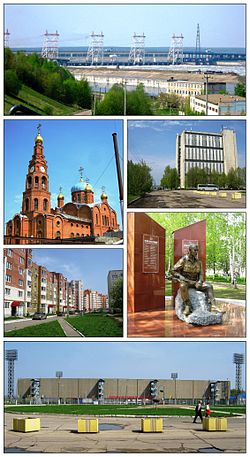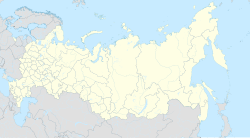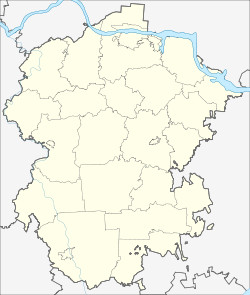Novocheboksarsk: Difference between revisions
Leništudent (talk | contribs) m →Media: fixing links |
Expanded sections on History and Culture, added interlanguage links and fixed incorrect wikilinks, marked unreferenced information. |
||
| Line 66: | Line 66: | ||
==History== |
==History== |
||
It was founded in 1960 when a trend of building [[satellite city|satellite cities]] started.<ref name="about">{{cite web |title= |script-title=ru:История |trans-title=History |url=http://gov.cap.ru/SiteMap.aspx?id=5085&gov_id=82 |url-status=live |archive-url=https://web.archive.org/web/20230329164735/https://old-nowch.cap.ru/sitemap.aspx?id=5085 |archive-date=2023-03-29 |access-date=2024-05-17 |website=old-nowch.cap.ru |publisher=Novocheboksarsk |language=ru}}</ref> Designed by [[Architect|architects]] from [[Saint Petersburg|Leningrad]], the city was initially called Sputnik ({{Lang-ru|Спутник}}).<ref name="about" /> Starting from relatively undeveloped land, the city grew to absorbed surrounding villages, such as {{Interlanguage link|Yelnikovo, Chuvashia|lt=Yelnikovo|ru|Ельниково (Чувашия)}}, {{Interlanguage link|Urakovo, Chuvashia|lt=Urakovo|ru|Ураково (Чувашия)}}, {{Interlanguage link|Yandashevo|ru|Яндашево}}, {{Interlanguage link|Anatkasy, Mariinsko-Posadsky District|lt=Anatkasy|ru|Анаткасы (Мариинско-Посадский район)}}, and {{Interlanguage link|Tsygankasy|ru|Цыганкасы}}.<ref name="about" /> The first foundation was laid by a team of concrete workers on November 18, 1960.<ref name="about" /> The first street in the city was opened on July 12, 1962, which included a [[school]], a club, a [[library]], a [[Public bathing|bathhouse]], a [[restaurant]], a [[Marketplace|market]], and a transportation center.<ref name="about" /> On |
|||
It was founded in 1960 when a trend of building [[satellite city|satellite cities]] started.<ref name="about">{{cite web|title=General Information|url=http://gov.cap.ru/SiteMap.aspx?id=5085&gov_id=82|publisher=Chuvash Republic|language=ru|access-date=September 3, 2017}}</ref> Starting from barren land, the growing town absorbed surrounding villages, such as [[Yelnikovo]], [[Urakovo]], [[Yandashevo]], [[Anatkasy]], and [[Tsygankasy]]. |
|||
On August 11, 1965, the government of the [[Chuvash Autonomous Soviet Socialist Republic|Chuvash ASSR]] adopted a resolution giving administrative status to the city, now known as Novocheboksarsk.<ref name="about" /> The resolution resulted in the city administratively absorbing the nearby villages of {{Interlanguage link|Bannovo, Chuvashia|lt=Bannovo|ru|Банново (Чувашия)}}, {{Interlanguage link|Ivanovo (Novocheboksarsk)|lt=Ivanovo|ru|Иваново (Новочебоксарск)}}, {{Interlanguage link|Oldeyevo|ru|Ольдеево}}, {{Interlanguage link|Tenekassy|ru|Тенеккасы}}, {{Interlanguage link|Chyodino|ru|Чёдино}}, and Yandashevo.<ref name="about" /> |
|||
November 18, 1960 is customarily considered to be the city's birthday.<ref name="about"/> City status was granted in 1971.<ref name="about"/> The city grew at a rapid rate; in 1978 it covered {{convert|1|km2|sp=us}}, and on October 29, 1983 it passed 100,000 inhabitants. |
|||
On December 27, 1971 the [[Presidium of the Supreme Soviet of the Russian Soviet Federative Socialist Republic|Presidium of the Supreme Soviet of the Russian SFSR]] issued the Decree "On Granting the City of Novocheboksarsk of the Chuvash ASSR the Status of a City Under Republic Jurisdiction", giving Novocheboksarsk city status.<ref name="about" /> |
|||
The city grew at a rapid rate, and on October 29, 1983 it passed 100,000 inhabitants.<ref name="about" /> |
|||
It was designed by architects from Leningrad. One of its first streets was Vinokurova, site of a 1985 monument to I. S. Semenovu. Another monument commemorates victims of the [[Eastern Front (World War II)|Great Patriotic War]]. Another honors [[Vladimir I of Kiev]]. |
|||
In 1985, a monument was erected on Vinokurova Street to I. S. Semenovu, who fought to established [[Soviet Union|Soviet]] power in Chuvashia.<ref name="about" /> |
|||
The city consists of three residential areas comprising eighteen [[microdistrict]]s.<ref>{{cite web |
The city consists of three residential areas comprising eighteen [[microdistrict]]s.<ref>{{cite web |
||
|title=History of Novocheboksarsk (История города) |
|title=History of Novocheboksarsk (История города) |
||
|url=http://gov.cap.ru/hierarhy.asp?page=./5076/5083/5085 |
|url=http://gov.cap.ru/hierarhy.asp?page=./5076/5083/5085 |
||
|access-date = 2006-03-17|language=ru}}</ref> |
|access-date = 2006-03-17|language=ru}}</ref><ref>{{cite web |
||
<ref>{{cite web |
|||
|title=Site of Novocheboksarsk (Новочебоксарск) |
|title=Site of Novocheboksarsk (Новочебоксарск) |
||
|url=http://n4eb.net |
|url=http://n4eb.net |
||
| Line 86: | Line 87: | ||
|archive-date=October 11, 2007 |
|archive-date=October 11, 2007 |
||
|url-status=dead |
|url-status=dead |
||
| ⚫ | |||
}}</ref> |
|||
<ref>{{cite web |
|||
|title=Хоккейный клуб Сокол Новочебоксарск (Hockey club Sokol Novocheboksarsk) |
|||
| ⚫ | |||
==Administrative and municipal status== |
==Administrative and municipal status== |
||
Within the [[subdivisions of Russia#Administrative divisions|framework of administrative divisions]], it is, together with the [[village#Russia|village]] of |
Within the [[subdivisions of Russia#Administrative divisions|framework of administrative divisions]], it is, together with the [[village#Russia|village]] of {{Interlanguage link|Oldeyevo|ru|Ольдеево}}, incorporated as the '''[[city of federal subject significance|city of republic significance]] of Novocheboksarsk'''—an administrative unit with the status equal to that of the [[administrative divisions of the Chuvash Republic|districts]].<ref name="Ref37">Law #28</ref> As a [[subdivisions of Russia#Municipal divisions|municipal division]], the city of republic significance of Novocheboksarsk is incorporated as '''Novocheboksarsk Urban Okrug'''.<ref name="Ref39">Law #37</ref> |
||
== |
== Culture == |
||
=== Media === |
|||
''The journal of the [[Roerichism#The World Organisation of Culture of Health (WOCH)|World Organisation of Culture of Health]] (″World Health Culture Organization″)'' is based in Novocheboksarsk. In 1995, [[Victor Skumin]] became the first [[editor-in-chief]] of the journal ''To Health via Culture''. The journal received an [[International Standard Serial Number]] (ISSN) 0204–3440. The main topics of the magazine are the dissemination of ideas of [[Victor Skumin#Culture of Health, Agni Yoga and Theosophy|Culture of Health]], [[holistic medicine]], [[Agni Yoga]] and [[Roerichism]].<ref>{{cite web |url=https://catalog.loc.gov/vwebv/search?searchCode=STNO&searchType=1&recCount=25&searchArg=0204-3440 |title=K zdorovʹi︠u︡ cherez kulʹturu: zhurnal Mezhdunarodnogo obshchestvennogo dvizhenii︠a︡ "K zdorovʹi︠u︡ cherez kulʹturu" |trans-title=To health via culture: Journal of the World Health Culture Organization |publisher=catalog.loc.gov |oclc=70966742 |access-date=22 February 2024 |archive-url=https://web.archive.org/web/20211121104312/https://catalog.loc.gov/vwebv/search?searchCode=STNO&searchType=1&recCount=25&searchArg=0204-3440 |archive-date=21 November 2021 |url-status=live}}</ref> |
''The journal of the [[Roerichism#The World Organisation of Culture of Health (WOCH)|World Organisation of Culture of Health]] (″World Health Culture Organization″)'' is based in Novocheboksarsk. In 1995, [[Victor Skumin]] became the first [[editor-in-chief]] of the journal ''To Health via Culture''. The journal received an [[International Standard Serial Number]] (ISSN) 0204–3440. The main topics of the magazine are the dissemination of ideas of [[Victor Skumin#Culture of Health, Agni Yoga and Theosophy|Culture of Health]], [[holistic medicine]], [[Agni Yoga]] and [[Roerichism]].<ref>{{cite web |url=https://catalog.loc.gov/vwebv/search?searchCode=STNO&searchType=1&recCount=25&searchArg=0204-3440 |title=K zdorovʹi︠u︡ cherez kulʹturu: zhurnal Mezhdunarodnogo obshchestvennogo dvizhenii︠a︡ "K zdorovʹi︠u︡ cherez kulʹturu" |trans-title=To health via culture: Journal of the World Health Culture Organization |publisher=catalog.loc.gov |oclc=70966742 |access-date=22 February 2024 |archive-url=https://web.archive.org/web/20211121104312/https://catalog.loc.gov/vwebv/search?searchCode=STNO&searchType=1&recCount=25&searchArg=0204-3440 |archive-date=21 November 2021 |url-status=live}}</ref> |
||
== |
=== Monuments === |
||
The city is home to several [[Monument|monuments]]. On Vinokurova Street, there is a monument to to I. S. Semenovu, who fought to established [[Soviet Union|Soviet]] power in Chuvashia.<ref name="about" /> On Gidrostroiteley Boulevard, there is a monument to local residents who died during the [[Eastern Front (World War II)|Great Patriotic War]].<ref name="about" /> |
|||
=== |
=== Churches === |
||
The Church of the Holy Equal-to-the-Apostles Prince Vladimir, First Baptist of Rus' is a major church in the city.<ref name="about" /> |
|||
| ⚫ | Novocheboksarsk has a trolleybus system, buses and minibuses. The trolleybus fare is 24 cents, and the bus fare is 31 cents. The most popular is the minibus, which has 7 routes and 95 minibuses on them. The trolleybus system consists of 5 routes with a length of 121 kilometers and 56 trolleybuses on them. |
||
== Transportation == |
|||
| ⚫ | Novocheboksarsk has {{Interlanguage link|Novocheboksarsk Trolleybus system|lt=a trolleybus system|ru|Новочебоксарский троллейбус}}, buses and minibuses. The trolleybus fare is 24 cents, and the bus fare is 31 cents.{{Citation needed|date=May 2024}} The most popular is the minibus, which has 7 routes and 95 minibuses on them.{{Citation needed|date=May 2024}} The trolleybus system consists of 5 routes with a length of 121 kilometers and 56 trolleybuses on them.{{Citation needed|date=May 2024}} |
||
Commercial taxi services are available too. |
Commercial taxi services are available too.{{Citation needed|date=May 2024}} |
||
==Twin towns and sister cities== |
==Twin towns and sister cities== |
||
Revision as of 16:14, 17 May 2024
Novocheboksarsk
Новочебоксарск | |
|---|---|
| Other transcription(s) | |
| • Chuvash | Ҫӗнӗ Шупашкар |
 Views of Novocheboksarsk | |
| Coordinates: 56°08′N 47°30′E / 56.133°N 47.500°E | |
| Country | Russia |
| Federal subject | Chuvashia[1] |
| Founded | November 18, 1960[2] |
| City status since | 1971[2] |
| Government | |
| • Body | City Assembly of Deputies |
| • Head[3] | Oleg Biryukov[3] |
| Area | |
| • Total | 36.7 km2 (14.2 sq mi) |
| Elevation | 90 m (300 ft) |
| Population | |
| • Total | 124,097 |
| • Rank | 131st in 2010 |
| • Density | 3,400/km2 (8,800/sq mi) |
| • Subordinated to | city of republic significance of Novocheboksarsk[1] |
| • Capital of | city of republic significance of Novocheboksarsk[1] |
| • Urban okrug | Novocheboksarsk Urban Okrug[5] |
| • Capital of | Novocheboksarsk Urban Okrug[5] |
| Time zone | UTC+3 (MSK |
| Postal code(s)[7] | 429950–429952, 429954–429956, 429958–429960, 429965 |
| OKTMO ID | 97710000001 |
| Website | gov |
Novocheboksarsk (Russian: Новочебокса́рск; Chuvash: Ҫӗнӗ Шупашкар, romanized: Śĕnĕ Şupaşkar) is a city in Chuvashia, Russia, located on the southern bank of the Volga River, about 3 kilometers (1.9 mi) east of Cheboksary, the capital of the republic. Population: 124,097 (2010 Census);[4] 125,857 (2002 Census);[8] 114,760 (1989 Soviet census).[9]
History
It was founded in 1960 when a trend of building satellite cities started.[2] Designed by architects from Leningrad, the city was initially called Sputnik (Russian: Спутник).[2] Starting from relatively undeveloped land, the city grew to absorbed surrounding villages, such as Yelnikovo, Urakovo, Yandashevo, Anatkasy, and Tsygankasy.[2] The first foundation was laid by a team of concrete workers on November 18, 1960.[2] The first street in the city was opened on July 12, 1962, which included a school, a club, a library, a bathhouse, a restaurant, a market, and a transportation center.[2] On
On August 11, 1965, the government of the Chuvash ASSR adopted a resolution giving administrative status to the city, now known as Novocheboksarsk.[2] The resolution resulted in the city administratively absorbing the nearby villages of Bannovo, Ivanovo, Oldeyevo, Tenekassy, Chyodino, and Yandashevo.[2]
On December 27, 1971 the Presidium of the Supreme Soviet of the Russian SFSR issued the Decree "On Granting the City of Novocheboksarsk of the Chuvash ASSR the Status of a City Under Republic Jurisdiction", giving Novocheboksarsk city status.[2]
The city grew at a rapid rate, and on October 29, 1983 it passed 100,000 inhabitants.[2]
In 1985, a monument was erected on Vinokurova Street to I. S. Semenovu, who fought to established Soviet power in Chuvashia.[2]
The city consists of three residential areas comprising eighteen microdistricts.[10][11][12] The available housing as of August 1, 1999 was 458 apartment houses: 39,452 apartments plus 4,033 rooms.
Administrative and municipal status
Within the framework of administrative divisions, it is, together with the village of Oldeyevo, incorporated as the city of republic significance of Novocheboksarsk—an administrative unit with the status equal to that of the districts.[1] As a municipal division, the city of republic significance of Novocheboksarsk is incorporated as Novocheboksarsk Urban Okrug.[5]
Culture
Media
The journal of the World Organisation of Culture of Health (″World Health Culture Organization″) is based in Novocheboksarsk. In 1995, Victor Skumin became the first editor-in-chief of the journal To Health via Culture. The journal received an International Standard Serial Number (ISSN) 0204–3440. The main topics of the magazine are the dissemination of ideas of Culture of Health, holistic medicine, Agni Yoga and Roerichism.[13]
Monuments
The city is home to several monuments. On Vinokurova Street, there is a monument to to I. S. Semenovu, who fought to established Soviet power in Chuvashia.[2] On Gidrostroiteley Boulevard, there is a monument to local residents who died during the Great Patriotic War.[2]
Churches
The Church of the Holy Equal-to-the-Apostles Prince Vladimir, First Baptist of Rus' is a major church in the city.[2]
Transportation
Novocheboksarsk has a trolleybus system, buses and minibuses. The trolleybus fare is 24 cents, and the bus fare is 31 cents.[citation needed] The most popular is the minibus, which has 7 routes and 95 minibuses on them.[citation needed] The trolleybus system consists of 5 routes with a length of 121 kilometers and 56 trolleybuses on them.[citation needed]
Commercial taxi services are available too.[citation needed]
Twin towns and sister cities
Novocheboksarsk is twinned with:
 Klimovsk, Russia
Klimovsk, Russia Sterlitamak, Russia
Sterlitamak, Russia Žatec, Czech Republic
Žatec, Czech Republic
References
Notes
- ^ a b c d e Law #28
- ^ a b c d e f g h i j k l m n o p История [History]. old-nowch.cap.ru (in Russian). Novocheboksarsk. Archived from the original on March 29, 2023. Retrieved May 17, 2024.
- ^ a b Official website of Novocheboksarsk. Oleg Borisovich Biryukov, Head of Novocheboksarsk Administration
- ^ a b Russian Federal State Statistics Service (2011). Всероссийская перепись населения 2010 года. Том 1 [2010 All-Russian Population Census, vol. 1]. Всероссийская перепись населения 2010 года [2010 All-Russia Population Census] (in Russian). Federal State Statistics Service.
- ^ a b c Law #37
- ^ "Об исчислении времени". Официальный интернет-портал правовой информации (in Russian). June 3, 2011. Retrieved January 19, 2019.
- ^ Почта России. Информационно-вычислительный центр ОАСУ РПО. (Russian Post). Поиск объектов почтовой связи (Postal Objects Search) (in Russian)
- ^ Federal State Statistics Service (May 21, 2004). Численность населения России, субъектов Российской Федерации в составе федеральных округов, районов, городских поселений, сельских населённых пунктов – районных центров и сельских населённых пунктов с населением 3 тысячи и более человек [Population of Russia, Its Federal Districts, Federal Subjects, Districts, Urban Localities, Rural Localities—Administrative Centers, and Rural Localities with Population of Over 3,000] (XLS). Всероссийская перепись населения 2002 года [All-Russia Population Census of 2002] (in Russian).
- ^ Всесоюзная перепись населения 1989 г. Численность наличного населения союзных и автономных республик, автономных областей и округов, краёв, областей, районов, городских поселений и сёл-райцентров [All Union Population Census of 1989: Present Population of Union and Autonomous Republics, Autonomous Oblasts and Okrugs, Krais, Oblasts, Districts, Urban Settlements, and Villages Serving as District Administrative Centers]. Всесоюзная перепись населения 1989 года [All-Union Population Census of 1989] (in Russian). Институт демографии Национального исследовательского университета: Высшая школа экономики [Institute of Demography at the National Research University: Higher School of Economics]. 1989 – via Demoscope Weekly.
- ^ "History of Novocheboksarsk (История города)" (in Russian). Retrieved March 17, 2006.
- ^ "Site of Novocheboksarsk (Новочебоксарск)" (in Russian). Archived from the original on October 11, 2007. Retrieved October 12, 2007.
- ^ "Хоккейный клуб Сокол Новочебоксарск (Hockey club Sokol Novocheboksarsk)" (in Russian).
- ^ "K zdorovʹi︠u︡ cherez kulʹturu: zhurnal Mezhdunarodnogo obshchestvennogo dvizhenii︠a︡ "K zdorovʹi︠u︡ cherez kulʹturu"" [To health via culture: Journal of the World Health Culture Organization]. catalog.loc.gov. OCLC 70966742. Archived from the original on November 21, 2021. Retrieved February 22, 2024.
Sources
- Государственный Совет Чувашской Республики. Закон №28 от 19 декабря 1997 г. «Об административно-территориальном устройстве Чувашской Республики», в ред. Закона №37 от 30 июля 2013 г. «О внесении изменений в отдельные законодательные акты Чувашской Республики и признании утратившим силу Закона Чувашской Республики "О едином балансе активов и пассивов Чувашской Республики"». Вступил в силу со дня официального опубликования. Опубликован: "Ведомости Государственного Совета ЧР", №23, 1998. (State Council of the Chuvash Republic. Law #28 of December 19, 1997 On the Administrative-Territorial Structure of the Chuvash Republic, as amended by the Law #37 of July 30, 2013 On Amending Several Legislative Acts of the Chuvash Republic and on Abrogating the Law of the Chuvash Republic "On Consolidated Balance of Assets and Liabilities of the Chuvash Republic". Effective as of the official publication date.).
- Государственный Совет Чувашской Республики. Закон №37 от 24 ноября 2004 г. «Об установлении границ муниципальных образований Чувашской Республики и наделении их статусом городского, сельского поселения, муниципального района и городского округа», в ред. Закона №54 от 9 октября 2015 г. «О внесении изменений в Закон Чувашской Республики "Об установлении границ муниципальных образований Чувашской Республики и наделении их статусом городского, сельского поселения, муниципального района и городского округа"». Вступил в силу через 10 дней со дня официального опубликования. Опубликован: "Республика", №49-50, 30 ноября 2004 г. (State Council of the Chuvash Republic. Law #37 of November 24, 2004 On Establishing the Borders of the Municipal Formations of the Chuvash Republic and on Granting Them Status of Urban, Rural Settlement, Municipal District, and Urban Okrug, as amended by the Law #54 of October 9, 2015 On Amending the Law of the Chuvash Republic "On Establishing the Borders of the Municipal Formations of the Chuvash Republic and on Granting Them Status of Urban, Rural Settlement, Municipal District, and Urban Okrug". Effective as of the day which is 10 days after the official publication date.).




